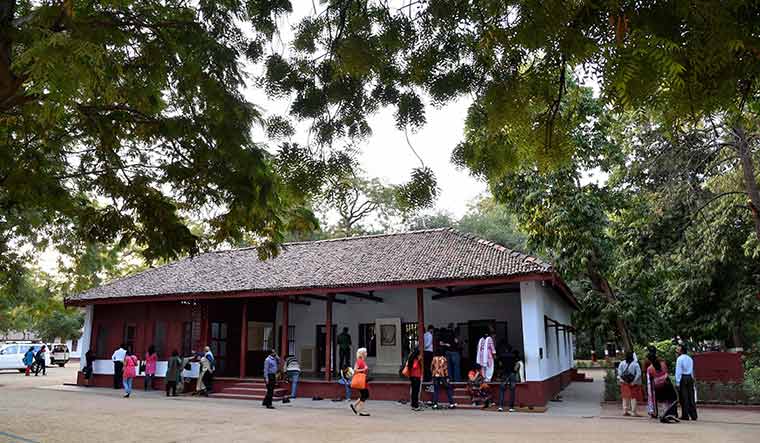IT IS PAST NOON, and the road outside the Gandhi Ashram on the banks of the Sabarmati in Ahmedabad is crowded. Noisy vehicles are all over the place. Less than half a kilometre away, a hotel hosts a wedding ceremony. If you are a visitor trying to experience the tranquillity of the ashram founded by Mahatma Gandhi, you will be disappointed.
Gandhi and Kasturba lived in the Sabarmati Ashram from 1917 to 1930. The ashram stands in a five-acre complex, which has a few other buildings of historical significance. The Gujarat government has now come up with a plan―originally a brainchild of Prime Minister Narendra Modi―to restore and refurbish the ashram and provide visitors a seamless experience. The project will be executed by the Ahmedabad Municipal Corporation.
The design of the restoration project will be done by Ahmedabad-based architect Bimal Patel, who is also behind the design of Central Vista in New Delhi and the Kashi Vishwanath corridor in Varanasi. Under the plan, the existing five-acre area will be expanded to 55 acres. Gandhi’s residence Hriday Kunj, which is at the heart of the ashram complex, and other structures constructed before 1930 will remain untouched. However, 263 families―descendants of Gandhi’s associates who came to live here when the ashram was founded―are being moved out from the complex. The Rs1,200-crore project, supported by the Gujarat government, has a provision for fair compensation for these families.
Kartikeya Sarabhai, chairman of the Sabarmati Ashram Memorial and Preservation Trust, said there were two key challenges in executing the project: resettling the inmates and closing down the four-lane road outside for vehicular traffic. “We have been able to convince the families and now only 15-odd families remain,” he said. Once the town planning scheme is complete, the road will be closed and traffic will be diverted to other roads.
The idea is to do the restoration in such a manner that the basic character of the place is retained, said Sarabhai. It often poses a challenge. He said there was a suggestion to place a red carpet near Hriday Kunj. The trust refused, and suggested a brown, inexpensive carpet that suited the environment. Sarabhai said the idea was to keep it simple and aesthetic, while meeting all the requirements.
Under the plan, the other side of the four-lane road will also be modelled like the ashram complex. Currently, that area has houses of inmates, some khadi shops and a few restaurants, including one run by the government. Even the government restaurant will go, as it is not congruent with the restoration project.
Sudarshan Iyengar, one of the trustees and a former vice chancellor of the Gujarat Vidyapith set up by Gandhi, said the ashram required some peace and solitude and that the trust had been talking to the government about it for a very long time. He, however, wants more consultations with all stakeholders. “The 55-acre project should not intimidate ordinary souls who come to the ashram, considering it a pilgrimage,” he said. But he thinks the ongoing project is a step in the right direction. “Just because the government is right-wing, it does not mean that everything has to be doubted. The merit of the subject needs to be seen.”
Ahmedabad deputy municipal commissioner I.K. Patel said the heritage buildings in the ashram would be preserved. K. Kailashnathan, who heads the executive council of the Gandhi Ashram Memorial and Precinct Development Project, has told a section of the media that not one brick of the Hriday Kunj or any other heritage building that existed during Gandhi’s time would be touched. But not everyone is convinced. Gandhi’s great-grandson Tushar Gandhi went to the Gujarat High Court seeking a stay on the project, but it was not granted. More than 100 people, including Gandhi’s grandson Rajmohan Gandhi and historian Ramachandra Guha had claimed in a statement that the plan trivialised the importance of the ashram.
One of the residents of the place, Hemant Chauhan, said the government paid different compensations to different inmates for moving out. He was one of the three inmates who resigned from the committee that was formed to coordinate with the inmates. He said there was no clarity in the plan. Chauhan runs a restaurant bang opposite the ashram. He said he would want to continue his business at the same place. Patel clarified that any takeover of property would be done only after proper counselling.
Restoring the ashram is one of the projects close to Modi’s heart. In the past there have been multiple attempts to restore the ashram, but no one was able to pull it off. If the ground work in the ashram can start before the Lok Sabha elections next year, it will be yet another key campaign plank for Modi and the BJP.


